1. Introduction: Raptors on the Move
Every year, billions of birds migrate across the globe—crossing continents, oceans, and mountains in search of food, breeding grounds, and better conditions. Among them, raptors—hawks, eagles, falcons, vultures—make some of the most impressive and perilous journeys.
Unlike songbirds that often migrate at night and over open water, most raptors are diurnal migrants. They rely on daytime thermals and updrafts to soar, conserving energy. But that also means they’re shaped by topography—they avoid flying over large stretches of open water and instead follow land features like mountains and coastlines. In some areas, the landscape naturally funnels raptors into narrow passages where thousands, even millions, can be seen passing through. These are known as migration bottlenecks, and they’re among the most thrilling places in the world to observe birds of prey.
Today, I’ll take you on a tour of five of the world’s most spectacular raptor migration sites—from the forests of Pennsylvania to the coastlines of Mexico, Georgia, Thailand, and southern Spain. Each one shows us something different about migration—and about our relationship with these birds.
1. Hawk Mountain Sanctuary
Now let’s turn to Hawk Mountain Sanctuary in Pennsylvania, one of North America’s most famous raptor migration observatories. Hawk Mountain sits on the Kittatinny Ridge in the Appalachian Mountains. Established in 1934, it was the world’s first refuge specifically for birds of prey. It’s not just a great place to see raptors—it’s a historic center for conservation, research, and public education.
Geography and migration mechanism
So why do so many raptors migrate past Hawk Mountain? The answer lies in the geography of the Ridge-and-Valley Province of the Appalachians. The Kittatinny Ridge forms a long, linear “leading line” for migrating birds. Raptors avoid expending energy by flapping—so they seek out rising air to soar. At Hawk Mountain, winds hitting the ridge slopes create orographic lift, or updrafts. On sunny days, thermals—columns of rising warm air—also help them gain altitude. Together, these natural features create a migratory highway that guides and concentrates raptors along the ridge.
Migration spectacle and scale
Each autumn—from mid-August through mid-December—tens of thousands of raptors follow this path. The site averages around 80,000 migrants in fall. On peak days, you might see over 3,000 birds, with record single-day counts exceeding 6,800. Spring migration (April to mid-May) is smaller in scale but still impressive, with daily counts often over 100. Species include broad-winged hawks (famous for “kettling” in large spirals), sharp-shinned hawks, American kestrels, bald and golden eagles, falcons, harriers, vultures, and ospreys.
Visitor experience and viewing setup
Visitors can observe this migration from multiple scenic lookouts. The North Lookout offers panoramic 240° views after a 1.5 km hike, while the South Lookout is wheelchair accessible. Staff, trainees, and volunteers are on hand to help spot and identify raptors. Free public programs include “Raptors Up Close!” and “Name That Raptor,” making it a true outdoor classroom. To get the best views, timing and weather are key. In autumn, ideal conditions are often right after a cold front brings strong northwest winds. These winds push birds close to the lookouts, riding the ridge lift. Typically, the best hours are mid-morning (around 9:30–11:30 am) and mid-afternoon (2:30–4 pm), though windy days can produce all-day flights starting at dawn.
Conservation significance
Hawk Mountain isn’t just about watching birds—it’s about protecting them. Founded to stop the slaughter of migrating raptors in the 1930s, it has become a model for conservation. Its migration count is the oldest continuous raptor monitoring program in the world, contributing decades of data on population trends and migration patterns. This long-term dataset is vital for tracking environmental change and informing conservation strategies.
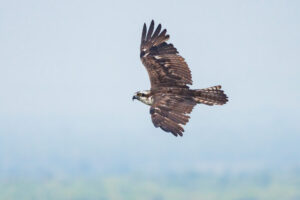

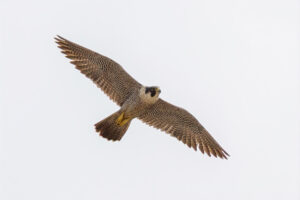
2. Veracruz, Mexico
Veracruz, on the Gulf Coast of eastern Mexico, is home to the largest concentration of migrating raptors on Earth. Known as the River of Raptors, it sees 4 to 6 million raptors pass through each autumn—more than anywhere else in the world. The secret to Veracruz’s incredible numbers lies in geography. Raptors funnel southward through eastern North America, avoiding the Gulf of Mexico. Veracruz sits at the junction of two major flyways—the Mississippi and the Atlantic—making it a natural convergence point. To the east lies the Gulf, which raptors avoid because there are no thermals over water. To the west, mountain ranges and arid highlands are less favorable for soaring. So the birds are squeezed into a narrow corridor between the coast and the Sierra Madre Oriental mountains—forming an ideal bottleneck. Peak migration occurs in September and October, when daily counts can exceed 300,000 raptors in a single day. Most numerous are broad-winged hawks, Swainson’s hawks, turkey vultures, and mississippi kites, many of them flying in enormous flocks or kettles. Unlike some other sites, Veracruz is largely a lowland site—with viewing platforms in the towns of Cardel and Chichicaxtle. Counters and observers track migration from rooftops and towers, often under intense heat and humidity. Despite the harsh conditions, it’s one of the most awe-inspiring bird spectacles on the planet. And just as importantly, Veracruz is also a story of community involvement. Local conservation groups like Pronatura Veracruz help monitor migration and engage communities through education, ecotourism, and citizen science. The River of Raptors isn’t just a biological event—it’s a cultural one too.
Veracruz is not alone in the region. Central America also offers spectacular migration viewpoints: Kekoldi, in Costa Rica, is famous for massive autumn flights of raptors moving through Caribbean lowlands. Cerro Ancón, in Panama City, is another excellent spot to watch huge numbers of migrating raptors funnel through the Isthmus. These sites underscore how migration connects continents, creating a chain of critical habitats and observation points all the way from North to South America.
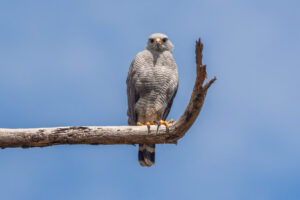

3. Khao Dinsor, Thailand
Now let’s head to Asia, to one of the most remarkable migration watchpoints in the region: Khao Dinsor in southern Thailand. While less known internationally than Veracruz or Batumi, Khao Dinsor has become a premier site for studying and watching raptor migration in Southeast Asia. Located on a forested ridge that juts into the Gulf of Thailand, Khao Dinsor serves as a critical bottleneckfor raptors moving south from continental Asia toward the Malay Peninsula and beyond. Just like other bottlenecks, geography is the key. The ridge acts as a leading line that channels raptors along the narrow Kra Isthmus—the slimmest part of the Thai peninsula. Most raptors here avoid long water crossings. As they move south, the mountains and coastline steer them into a narrow front over Khao Dinsor, creating spectacular concentrations. During peak migration in September and October, observers can see tens of thousands of raptors per day. Species diversity is another highlight. Khao Dinsor is famous for huge movements of Chinese sparrowhawks and Japanese sparrowhawks, often in swirling flocks. But visitors can also see grey-faced buzzards, Oriental honey-buzzards, black baza, eagles, and even Amur falcons—a small falcon that undertakes one of the longest raptor migrations in the world. The viewing experience is also special. Observers climb to viewpoints on the ridge itself—giving them an eye-level view of raptors riding thermals and gliding southward, often incredibly close. The setting is lush and tropical, with green forests and views over the Gulf of Thailand. Khao Dinsor has also become an important site for research and conservation. Thai ornithologists and international volunteers conduct systematic counts, helping track population trends and migration timing in Asia—data that was scarce just a couple of decades ago. The site also draws birders and ecotourists from around the world, supporting local economies and building awareness about conserving raptors and their habitats. In short, Khao Dinsor is a brilliant example of Asia’s migration spectacles, blending breathtaking numbers, diverse species, and frontline conservation efforts.
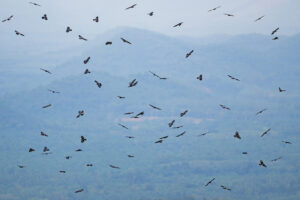

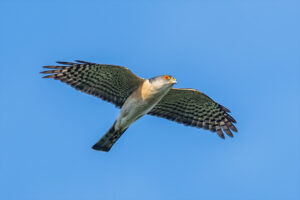
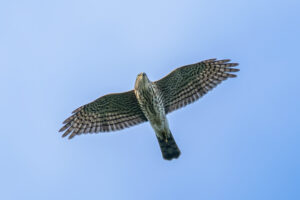
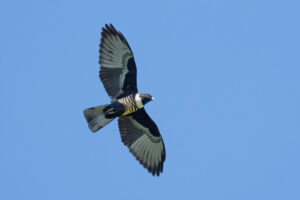
4. Batumi, Georgia
Next, we travel to the eastern edge of the Black Sea—to Batumi, in the Republic of Georgia. Batumi is one of the most important raptor migration bottlenecks in the Old World, with more than a million raptorspassing through each autumn. What makes Batumi so special is its unique geography. The Caucasus Mountains run east–west just inland from the Black Sea coast. Raptors migrating south from Russia, Eastern Europe, and western Asia face two barriers: the high peaks of the Caucasus to the east, and the open sea to the west. To avoid both, they’re funneled through a narrow coastal plain near Batumi—sometimes just a few kilometers wide. In September and early October, this natural bottleneck channels enormous numbers of raptors. Daily counts can exceed 100,000 birds, and peak days can be breathtaking: massive flocks of honey buzzards, steppe buzzards, black kites, eagles, harriers, and sparrowhawks all soaring overhead. Batumi is especially famous for its diversity of migrating raptors—more than 35 species have been recorded in large numbers. Unlike some sites dominated by a few species, Batumi offers a chance to see a wide array of birds, from slender harriers skimming low over fields to giant steppe eagles gliding on thermals. But Batumi is also a place where conservation meets challenge. Historically, illegal hunting of migrating raptors was widespread here. In recent years, however, local and international conservation groups have worked to reduce persecution through education, monitoring, and community engagement. The Batumi Raptor Count, launched in 2008, is a major volunteer-driven monitoring program that has helped both science and local awareness. For birders and scientists alike, Batumi is not just a world-class migration watchpoint—it’s also a model of how science, tourism, and conservation can come together to protect raptors along their ancient flyways.
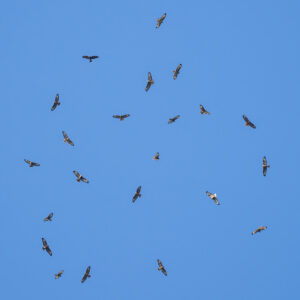
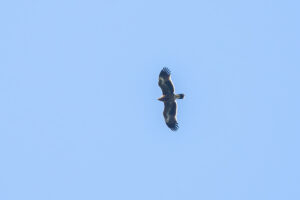

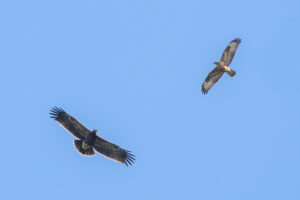
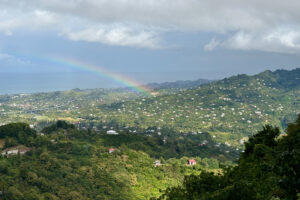
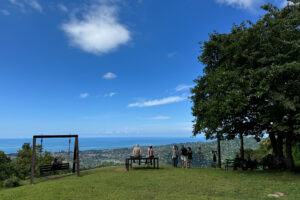
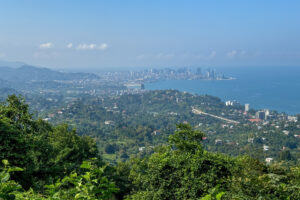
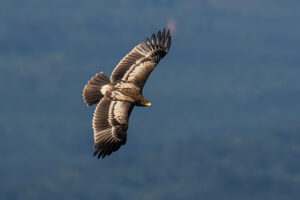
5. Strait of Gibraltar, Spain
Finally, let’s travel to Western Europe’s gateway to Africa: the Strait of Gibraltar. This narrow waterway—just 14 km wide at its narrowest—forms one of the most famous migration bottlenecks in the Western Palearctic. For raptors migrating between Europe and Africa, the strait represents both an obstacle and a bridge. Many species are reluctant to cross long stretches of open water, as they depend on thermal updrafts to soar with minimal energy. Over water, those thermals are weak. The narrow crossing at Gibraltar offers the shortest possible sea route, making it the natural choice for migrating raptors. Each autumn, from August through October, hundreds of thousands of raptors funnel south along the Iberian Peninsula. As they approach the Strait, the birds are channeled by geography and wind patterns into a concentrated front. Species like black kites, booted eagles, short-toed snake eagles, honey buzzards, Egyptian vultures, and many others gather here in spectacular numbers. On peak days in late August and September, observers may count 10,000 or more raptors crossing south into Morocco. Spring migration is equally fascinating but tends to be more spread out in time and with slightly lower daily peaks. Winds play a critical role. Favorable winds—light easterlies or southerlies—help birds cross safely. Strong westerlies can block them, forcing raptors to wait in large numbers on the Spanish side. This can lead to spectacular “waiting days” with massive concentrations visible from hilltop watchpoints like Cazalla or El Algarrobo near Tarifa. What also makes the Strait of Gibraltar special is its remarkable species diversity. More than 30 raptor species are regularly recorded here. It’s also one of the few places in Europe to see large numbers of African raptors mixing with European migrants during the crossing. Another advantage of visiting the Strait is that it’s one of the easiest and most comfortable migration watchpoints for visitors. The town of Tarifa, the main base for raptor migration trips, offers an appealing mix of wild beaches, whale watching, .excellent hotels, and great restaurants. This makes it possible to enjoy world-class migration watching while also having all the amenities you might want on hand. In short, the Strait of Gibraltar is a classic migration bottleneck that not only delivers unforgettable wildlife viewing but also plays a vital role in conserving raptors on their intercontinental journeys.
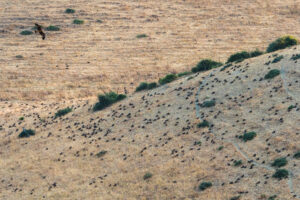
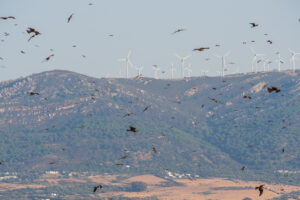
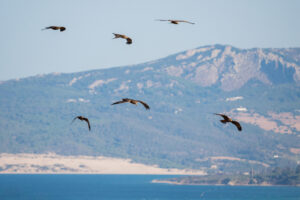
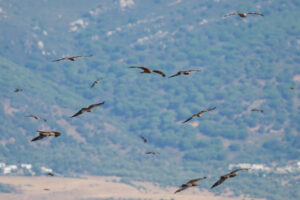
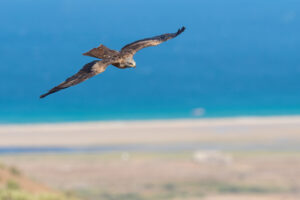

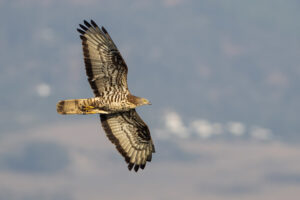
Conclusion
So to finish, what unites these incredible places—Hawk Mountain, Veracruz, Batumi, Khao Dinsor, and the Strait of Gibraltar? They’re not just geographic bottlenecks where raptors are funneled into breathtaking numbers. They’re also gathering places for people—where birders, scientists, volunteers, and local communities come together year after year. Watching migration at these sites is as much about community as it is about the birds. It’s a chance to share knowledge, build friendships, and feel part of something bigger. These observatories also play a vital role in conservation and research, providing long-term data on migration trends and species health, and guiding efforts to protect birds across continents. But no matter how much I describe it, I have to admit: it’s impossible to truly transmit the feeling of standing on a ridge or a coastline as thousands of raptors swirl overhead. That emotion, that awe—it really can only be experienced in person. Before I finish, I want to take a moment to dedicate this talk to the memory of Sergio Seipke, who recently passed away. Sergio was a true raptor fanatic and a passionate advocate for raptor migration. Thanks to him, I was fortunate to experience firsthand some amazing migration hotspots, including Khao Dinsor. His enthusiasm and dedication continue to inspire all of us who love these magnificent birds. I hope this talk has not only informed you, but also encouraged you to go see one of these amazing migrations for yourself. And just before we finish: If anyone would like to talk more or has questions, I’ll be available at the Swallow Marquee, stands 88, 89, and 90. Feel free to come by and chat! Also, if you need more information about raptor migration, please visit my new website: raptormigration.com. It’s still in a raw version, and I’ll be adding more resources and details over time—but it’s there to help you dive even deeper into this fascinating topic. Thank you all so much for listening.